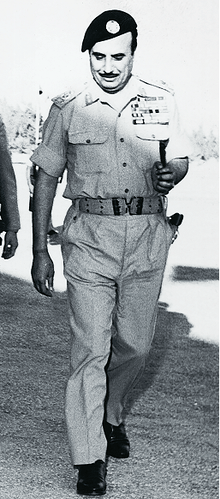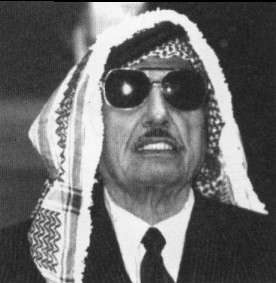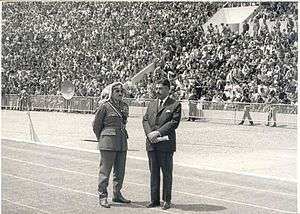Habis al-Majali
| Habis al-Majali Habis Pasha | |
|---|---|
 Habis al-Majali in 1960 | |
| Nickname(s) | Akho Khadra |
| Born |
1914[1] Ma'an, Jordan |
| Died |
April 22, 2001 (aged 86–87) Al Karak, Jordan |
| Allegiance |
|
| Years of service | 1932 – 1981 |
| Rank | Fieldmarshal |
| Commands held |
Arab Legion Jordanian Armed Forces |
| Battles/wars |
1948 Arab-Israeli War: -Battle of Latrun -Battles for Jerusalem 1967 War Black September in Jordan |
| Relations | Hazza' al-Majali Ayman Hazza' al-Majali Hussein Al-Majali |

Field Marshal Habis al-Majali (Arabic: حابس المجالي; 1914 – April 22, 2001) was a noted Jordanian soldier from the southern city of Al Karak, Habis served as Chief of staff, Jordanian Armed Forces 1958-1975, Minister of Defence 1967-1968, and 20-year member of the Jordanian Senate for 5 terms (1967, 1984, 1989, 1993 and 1997)
Life and career

Habis Pasha is the son of Sheik Refefan
Early career
Habis joined the Arab Legion in 1932, and soon impressed Glubb Pasha. Despite acquiring modern skills, he never lost his Bedouin elan. King Hussein's biographer, James Lunt, dubbed him the grand seigneur of Karak and beau sabreur of the army.
Habis Pasha was the only Arab commander to win military victories against Israelis, Palestinians and Syrians alike. His baptism of fire came during the first Arab-Israeli war, when he successfully defended the town of Latrun, 17 miles west of Jerusalem, against the Israelis.
The Jewish state had declared independence on May 14, 1948. The next day, the armies of five Arab nations invaded, among them the Transjordan's crack Arab Legion, under the supreme command of Glubb Pasha. They immediately secured the West Bank, then rushed to fill the vacuum created by British troops leaving Jerusalem.
Meanwhile, the Jewish forces were desperate to keep open their lines of communication with the 85,000 besieged Jews of Jerusalem at Latrun, the epicentre of the only route linking Tel Aviv with Jerusalem.
Lieutenant Colonel Majali, the first Arab to head a legion regiment, occupied a strategic hill straddling the nearby Bab al Wad (Gate to the Valley). His spies fanned the countryside, while he held a deserted British police fort, built near a Trappist monastery in 1936.
When the Haganah attacked on May 25, Majali's Fourth Regiment was ready. Their camouflaged mortars, machine-guns and cannon caught the mainly immigrant recruits on open ground, and cut them to shreds over 15 hours. two months before his death, Habis claimed that he had caught a young Lieutenant Ariel Sharon in the battle. The new Israeli prime minister denied the claim, but Habis was adamant. "Sharon is like a grizzly bear," he grumbled. "I captured him for 9 days, I healed his wounds and released him due to his insignificance.", few fellow high ranking Jordanian army officers testified in favour of this account, no others.[2]
On June 9, an Israeli Palmach strike-force attempted a second raid on Latrun. This, too, faltered for want of reinforcements, only yards from Majali's command post. In mid-July, he repulsed a final assault - and returned to Amman a thrice-conquering hero. He restored a modicum of pride to Arabs, for whom 1948 spelt nakba (disaster).
Nonetheless, it was a Pyrrhic victory. Despite their losses at Latrun, the Haganah pinned down Jordanian troops who might have been fighting in Jerusalem. The Israelis also managed to build a makeshift bypass round Latrun and siphoned through vital arms, water and supplies.
Majali's brigade commander, Colonel Ashton, forbade him from shelling their bulldozers. Ultimately, Transjordanian troops, assisted by local Arabs, did capture the Old City and East Jerusalem and demolished the Jewish Quarter.
It was in the Old City, three years later, that Habis Al-Majali experienced tragedy at first-hand. For two years, he had been the private escort to King Abdullah of Jordan. Then, on July 20, 1951, as he was ushering the king to prayers at the Al Aqsa mosque, Abdullah was shot dead by an anti-Hashemite Palestinian.
In the Stability of Jordan
Certainly, King Hussein found him indispensable. He ruthlessly tracked down the Hashemite ruler's Nasserite enemies during the uprising of 1958. In 1960, he restored order after pro-Syrian agents had murdered his cousin, the Jordanian prime minister, Hazza' al-Majali. Forced to relinquish overall command to Cairo on the eve of the Six-Day War in June 1967, and bemused by conflicting orders, he lost the West Bank to Israel. He resigned, but served as defence minister for another year.
There were more setbacks in store. Majali backed Prince Na'if as successor to the Jordanian throne, though, in the event, his elder brother, Prince Talal, won the crown. Matters only improved after King Hussein replaced his father, Talal, in 1953. Three years later, Glubb was dismissed, and, in 1957, Majali became chief-of-staff of the Jordanian armed forces, a post he held until June 1967.
Majali's return to active duty was sudden and dramatic. Jordanian-based Palestinian fedayeen (guerrillas) were growing more autonomous and audacious. After terrorists destroyed four international aircraft near army headquarters at al-Zarqa, in September 1970, Hussein declared martial law, re-appointed Majali as commander-in-chief, and ordered him to crush the revolt.
Habis did so with relish. Over 10 days, his troops routed the fedayeen; some 3,500 fighters died on both sides. He also repulsed a pro-PLO Syrian invasion - destroying half the enemy's armour in the process, and inadvertently setting off the coup that brought President al-Assad to power in Damascus. In July 1971, the remaining PLO units in Jordan were expelled to Lebanon.
Honour
Foreign honour
-
 Malaysia : Honorary Commander of the Order of the Defender of the Realm (1965)[3]
Malaysia : Honorary Commander of the Order of the Defender of the Realm (1965)[3]
Sources
http://www.vkrp.org/studies/cultural/simakiyya-study/info/elements-in-history.asp
References
- ↑
- ↑ http://www.theguardian.com/news/2001/apr/27/guardianobituaries
- ↑ "Senarai Penuh Penerima Darjah Kebesaran, Bintang dan Pingat Persekutuan Tahun 1965." (PDF).